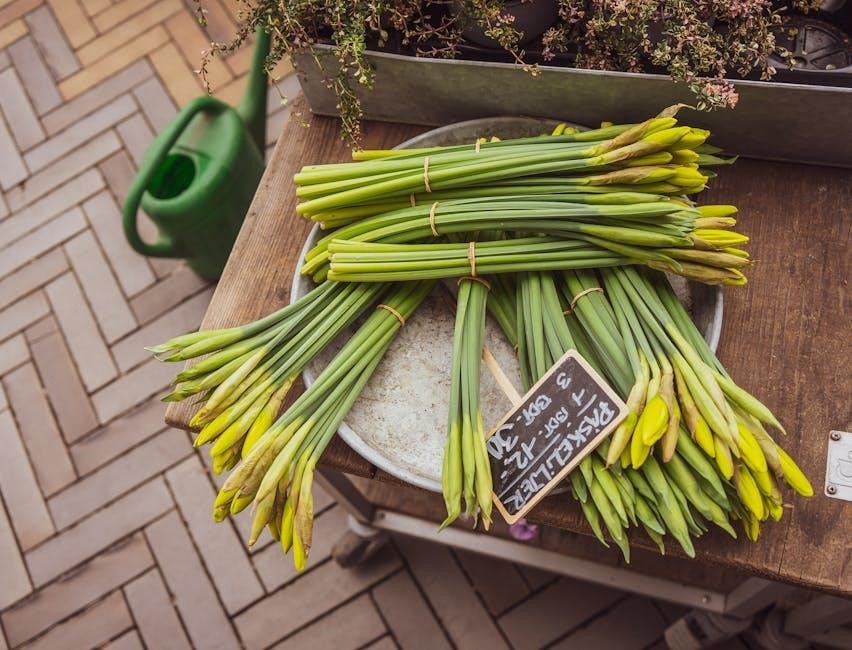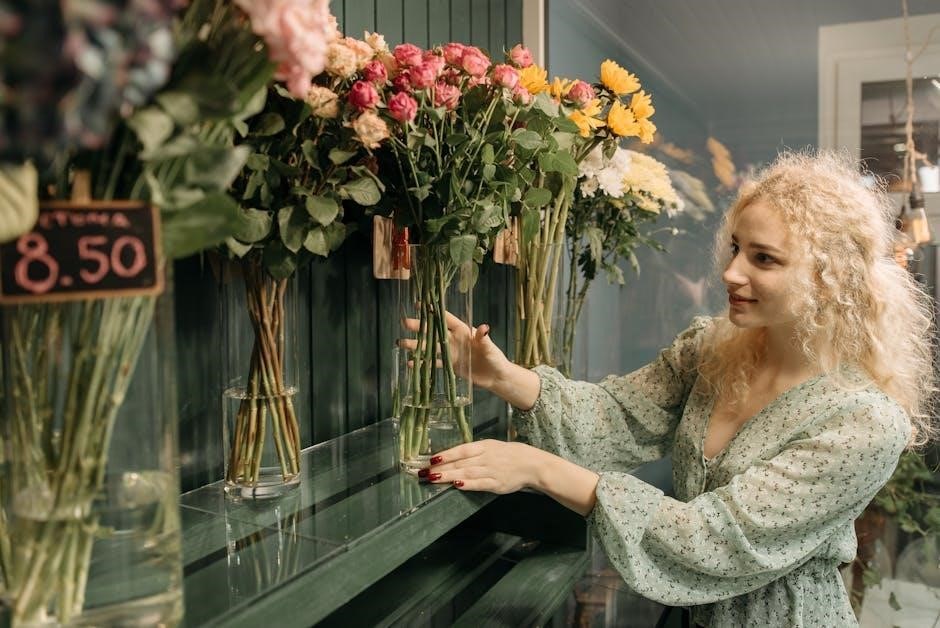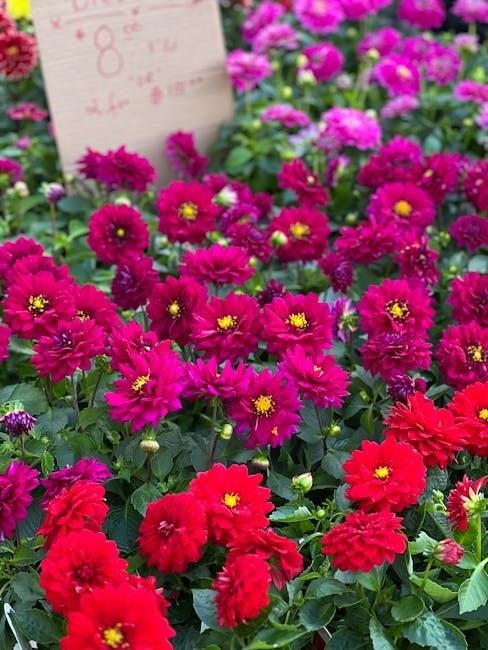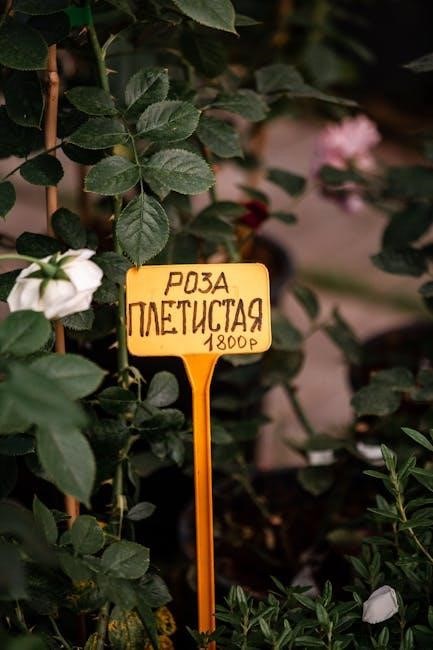floral pricing guide

A floral pricing guide helps businesses and clients understand costs, market trends, and profitability. It ensures transparency, sustainability, and balance between creativity and financial success in floristry.
Importance of Understanding Floral Pricing
Understanding floral pricing is crucial for both businesses and clients to set clear expectations and ensure fair transactions. It helps florists create sustainable profit margins while offering transparent breakdowns of costs. Pricing guides provide insights into market trends, seasonal fluctuations, and design complexities, enabling better budgeting and decision-making. By grasping floral pricing principles, businesses can balance creativity with financial stability, ensuring long-term growth. Clients also benefit from knowing the value behind their investments, fostering trust and satisfaction. Accurate pricing strategies are essential for maintaining profitability and meeting customer demands in a competitive and dynamic industry.

Overview of the Floral Industry Pricing Structure
The floral industry’s pricing structure varies based on factors like flower type, seasonality, and design complexity. Standard markups range from 3x to 5x the wholesale cost, with labor and materials adding to the final price. Retail pricing reflects these markups, ensuring profitability. Wholesale costs fluctuate seasonally, impacting retail rates. Custom designs and event-specific arrangements often carry higher premiums due to detailed planning and execution. Pricing transparency is key, helping clients understand the value behind each arrangement. This structure balances creativity with financial sustainability, ensuring florists can deliver quality while maintaining profitability in a competitive market.
Factors Affecting Floral Pricing
Floral pricing is influenced by flower type, seasonality, design complexity, location, and event specifics. These factors shape costs, availability, and demand, impacting final prices significantly.
Type of Flowers and Seasonality

The type of flowers and their seasonality significantly impact pricing. Rare or exotic blooms cost more due to limited availability, while seasonal flowers are often cheaper. For instance, roses in February are pricier because of high demand for Valentine’s Day. Additionally, flowers out of season may require importing, increasing costs. Pricing guides suggest adjusting rates based on these factors to ensure profitability. Understanding these dynamics helps florists set competitive yet sustainable prices, balancing client expectations with business needs. Seasonal fluctuations must be considered to maintain profit margins and customer satisfaction.

Design Complexity and Customization
Design complexity and customization play a crucial role in floral pricing. Intricate arrangements, such as wedding bouquets or large event installations, require more time, skill, and materials, increasing costs. Custom requests, like specific color schemes or unique flower combinations, also drive up prices. Clients often seek personalized designs, which involve additional planning and execution. Pricing guides suggest charging higher rates for complex designs to account for labor and creativity. The more detailed the design, the higher the cost, as it reflects the florist’s expertise and the effort invested in creating a bespoke piece. This ensures that both parties value the final product.
Location and event-specific requirements significantly impact floral pricing. Deliveries to remote areas or large venues often incur higher costs due to logistics and setup. For weddings and events, factors like venue size, installation complexity, and timing influence prices. Seasonal demand, such as holidays or peak wedding seasons, can also drive up costs. Additionally, event-specific requests like custom installations or overnight delivery may require premium pricing. These variables ensure that florists account for the unique demands of each event, providing tailored solutions while maintaining profitability. Transparent communication about these factors helps clients understand the value behind the pricing. Standard industry markups for florals typically range from 3x to 5x the wholesale cost, with an average of 3.5x. This ensures profitability while reflecting flower value and design effort. The 3x to 5x markup range is a standard pricing strategy in the floral industry, ensuring profitability while accounting for costs like materials, labor, and overhead. A 3x markup means tripling the wholesale price, while 5x reflects higher-value designs or premium services. For example, a $1 rose might sell for $3 to $5. This range allows florists to cover expenses and generate profit, with 3.5x being the average. It also accommodates factors like seasonality, design complexity, and location, ensuring competitive yet sustainable pricing. This approach helps businesses maintain profitability while offering fair prices to clients. To calculate profit margins in floristry, start by understanding the markup range and its impact on pricing. Profit margin is the percentage of profit after deducting costs like materials, labor, and overhead. For example, if a bouquet costs $50 to create and sells for $150, the profit is $100, yielding a 66.67% margin. Tools like Floral Math help florists accurately calculate retail pricing, wholesale costs, and profitability. By balancing markups with client expectations, florists can ensure sustainable pricing while maintaining quality and creativity. Transparency in pricing breakdowns also fosters trust with clients, making it easier to communicate value and justify costs. Dynamic pricing adjusts costs based on demand, seasonality, and market trends, ensuring optimal profitability while meeting client needs and staying competitive in the floral industry landscape. Seasonal demand significantly influences floral pricing, with prices rising during peak periods like Valentine’s Day and weddings. Event-based pricing adjusts costs for specific occasions, ensuring businesses capitalize on high-demand times while managing supply and demand efficiently. This strategy allows florists to balance profitability with customer expectations, offering tailored solutions that reflect current market conditions and event requirements. By understanding seasonal trends and event dynamics, florists can set competitive yet fair prices, maintaining profitability without compromising quality or client satisfaction. This approach is crucial for sustainability in the dynamic floral industry. Proper planning and adaptability are key to success in such pricing strategies. Competitor analysis is essential for understanding market trends and pricing strategies in the floral industry. By monitoring competitors’ pricing, product offerings, and marketing approaches, florists can identify gaps and opportunities. Market trends, such as seasonal demand fluctuations or shifts in consumer preferences, also play a crucial role in pricing decisions. For example, sustainable and eco-friendly arrangements are increasingly popular, influencing pricing structures. Analyzing competitors’ strengths and weaknesses helps florists position their services effectively. Staying informed about industry trends ensures pricing remains competitive while reflecting the value provided. This proactive approach enables businesses to adapt and thrive in a dynamic market landscape. A wedding floral pricing guide provides detailed cost breakdowns for bouquets, ceremony arrangements, and reception decor, helping couples budget effectively for their special day. Bridal bouquets and personal florals vary in price based on flower type, size, and design complexity. Hand-tied bouquets typically start at $95, while tear-drop styles begin at $135. Dried flower bouquets and crowns are also popular, priced around $95 and $75 respectively. These pieces are crafted to reflect the bride’s style, whether classic, rustic, or bohemian. Seasonal blooms and customization options further influence pricing, ensuring each floral piece is unique and meaningful for the wedding day. Ceremony and reception arrangements vary widely in cost, depending on size, flower selection, and design complexity. Ceremony arches often start at $1,500, while aisle arrangements may range from $100 to $300. Reception centerpieces typically cost between $75 and $300 each, depending on the number of flowers and design intricacy. Larger installations, such as floral walls or hanging arrangements, can exceed $2,000. Prices also reflect labor costs for setup and installation, which can add 20-40% to the total. These arrangements are tailored to fit the event’s theme and budget, ensuring a cohesive and memorable floral display for the celebration. A client-friendly pricing guide ensures transparency by breaking down costs, labor, and materials. It should be tailored to client needs, budgets, and preferences, fostering trust and clarity. Regular updates ensure the guide reflects current market trends and pricing fluctuations, maintaining relevance and client satisfaction. A clear pricing breakdown is essential for building trust with clients. It involves detailing the costs of materials, labor, and services. For example, specifying the price of flowers, foliage, and design time ensures clients understand where their money is spent. Additionally, explaining markups, such as the standard 3x to 5x range for fresh flowers, helps justify pricing. Transparency also includes highlighting any additional fees, like delivery or setup charges. By avoiding hidden costs and providing a detailed breakdown, florists foster trust and client satisfaction. This approach ensures clients feel informed and valued, making them more likely to return for future services. Transparency in pricing builds long-term relationships and enhances client confidence in your floral services. Effective communication of pricing is crucial for client satisfaction. Start by understanding their budget and expectations. Provide a detailed breakdown of costs, ensuring clarity on materials, labor, and services. Highlight any additional fees upfront to avoid misunderstandings. Use simple, non-technical language to explain pricing structures, such as markups and customizations. Offer flexibility by suggesting alternatives or packages tailored to their needs. Be transparent about seasonal fluctuations and availability of specific flowers. Encourage questions and address concerns promptly. Finally, present the pricing in a professional format, such as a written estimate or proposal, to reinforce trust and professionalism. Open and honest communication ensures clients feel valued and informed, fostering a positive relationship. Mastery of floral pricing ensures profitability and sustainability. This guide provides clarity and confidence, helping businesses adapt strategies to maintain profitability while attracting and satisfying clients effectively. Sustainable floral pricing balances creativity, profitability, and client satisfaction. By understanding cost components, adapting to market trends, and using dynamic strategies, florists can maintain profitability while offering fair prices. Ethical practices, like fair labor costs and eco-friendly sourcing, enhance sustainability. Transparency in pricing builds trust, ensuring long-term client relationships. Regularly updating pricing guides reflects seasonal changes and market demands, fostering a stable business model. Investing in education and tools, like floral math guides, helps florists make informed decisions. Sustainable pricing not only supports businesses but also satisfies clients, creating a win-win scenario for all involved in the floral industry.Location and Event-Specific Requirements
Standard Industry Markups for Florals
Understanding the 3x to 5x Markup Range

How to Calculate Profit Margins

Dynamic Pricing Strategies

Seasonal Demand and Event-Based Pricing

Competitor Analysis and Market Trends
Wedding Floral Pricing Guide
Bridal Bouquets and Personal Florals
Ceremony and Reception Arrangements

Creating a Client-Friendly Pricing Guide
Transparency in Pricing Breakdown
How to Communicate Pricing to Clients
Final Thoughts on Sustainable Floral Pricing





